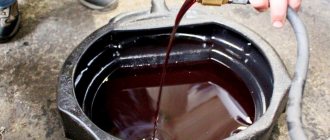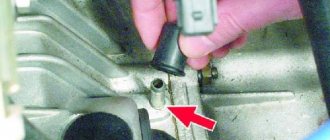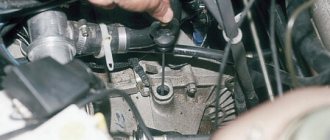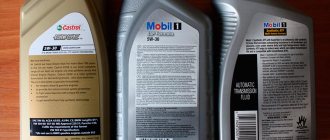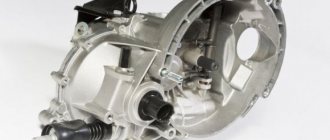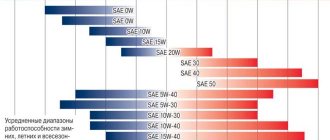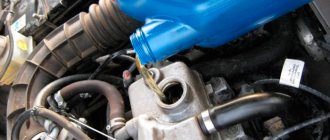Cars have already become a part of the life of modern people. Each family has one, or even 2-3 cars. And in order for them not to let their owners down, they need to do maintenance and change lubricants on time. It is important that they are of good quality and fit the technical parameters of the car. What kind of oil is safe to pour into a box? What is gear oil? Motorists will find answers to these and many other questions in the article.
Do I need to change the oil in the box?
Drivers, especially newbies, quite often forget that the gearbox oil requires regular replacement. They tend to think that one fill can cover more than several hundred kilometers.
And thus they cause irreparable harm to the vehicle, even to the point of replacing some technical components.
Automatic in the box
Oils intended for automatic transmissions must be changed strictly at intervals of 25,000-50,000 kilometers. If the car is operated carefully and not every day, then it is possible to reach 70,000 kilometers. But it must be borne in mind that the longer the owner delays changing the oil in the gearbox, the more it clogs.
This is explained by the loss of the lubricating fluid of its basic properties as wear products accumulate. As a result, the bushings and bearings begin to rub against each other - scuffing appears, accelerating the wear of all components.
It is even more dangerous if oil leaks are observed. This problem occurs especially often in winter. The transmission box is subjected to severe stress due to sudden temperature changes. As a result, gaps form at the junction with the engine and fluid gradually begins to leak out.
A sharply decreasing volume of oil in the box can lead to its complete failure.
In such cases they say that it “burned out.”
When planning an oil change in an automatic transmission, you need to focus on the following factors:
- vehicle age;
- type of lubricant;
- season;
- terms of Use;
- level of wear and more.
Changing the oil in the box can be done in two ways:
- full;
- partial.
The full one is carried out based on mileage. It is recommended to do partial maintenance every time during routine maintenance.
In mechanical box
Many drivers choose mechanics for themselves. But this unit is quite complex and the slightest malfunction quickly knocks it out of action. This also applies to oil poured into a mechanical gearbox. It must be changed at strictly established intervals. Otherwise:
- chips are formed;
- sediment appears;
- the degree of viscosity changes;
- foaming occurs;
- lubricating properties and more are reduced.
All of the above leads to premature wear of parts. The result could be:
- expensive repairs;
- complete replacement of the box.
In 90% of cases, manufacturers do not indicate how long to change the oil in a manual transmission.
But on average you need to focus on 50,000-60,000 kilometers. Depending on operating conditions, this interval may be increased or decreased.
Division of oils for manual transmissions by viscosity degree
Lubricants for manual transmissions are divided not only according to the manufacturing method, but also according to the SAE viscosity standard. Thanks to this parameter, you can decide on the transmission oil at certain times of the year. Unlike the API marking, SAE viscosity grades divide all lubricants into winter and summer.
For winter operation of a car with a manual transmission, compositions of the following types are used: 5W, 10W, 20W and others. It is the English letter W that determines the season in which it is recommended to use the lubricant.
The oil in a manual transmission should be changed when the season changes. Summer lubricants include the following SAE fluids without the distinctive letter “W”, for example, the following: 10, 15, 25, 30, 45 and others.
There are also all-season lubricants for mechanics, they look like this: 5W-40, 0W-30, 10W-50. Such compounds need to be replaced only when the oil level in the manual transmission drops, and not when the season changes.
How to check the oil in the box
Approximately every 50,000 kilometers traveled, car owners are recommended to monitor the amount of oil in the gearbox. The driver should also be alerted to extraneous sounds when changing gears or unusual behavior of mechanisms:
- tremors;
- grinding;
- hum;
- slow transition from one speed to another, and so on.
If such signs appear, the car cannot be further operated without first checking the quality and quantity of lubricating fluids in the engine and gearbox. Namely, oils.
Automatic in the box
How to check the oil in the box? Each car model has its own characteristics, but in general the process is identical except for minor nuances. Therefore, the oil in the Toyota box is monitored in the same way as, for example, for a Kia.
Initially, you need to find the right probe.
There are two of them under the hood:
- for the engine;
- for transmission.
Then you need to read the inscription on the dipstick. The most common options:
- HOT;
- COLD.
In the first case, control is carried out only in the wound-up state. The optimal result is shown not just by a running car, but by one that has previously driven several kilometers.
The second inscription means that before checking the car you need to start it and let it run for a few minutes. After turning off, it is permissible to take measurements and assess the condition of the liquid.
Now you can begin to describe how to check the oil in the box step by step:
- bring the car into proper condition (start or turn off);
- pull out the dipstick;
- wipe the device dry;
- lower the dipstick into the hole;
- wait about 10 seconds
- pull out;
- look carefully.
The optimal oil level in the box should be between two notches:
- maximum;
- minimum.
If it is close to the last inscription, then you should think about topping up. Exceeding the maximum is also fraught with problems and requires specialist intervention.
The condition of the oil in the automatic transmission is also a very important indicator. It's quite easy to check:
- prepare a piece of light and clean cloth;
- lower the device into the box;
- wait 10-15 seconds;
- pull out;
- wipe with a prepared cloth.
The correct oil in the box of a Nissan or any other car should be:
- without impurities;
- homogeneous consistency;
- transparent.
It is not recommended to judge its quality by the color of a liquid. Since after pouring it often changes to dark red or brown.
But the following signs indicate the need for an urgent oil change in the automatic transmission:
- impurities and metal particles;
- high degree of turbidity;
- foam;
- bubbling
The appearance of chips and metal inclusions is especially dangerous for the unit. They indicate that the mechanism is in urgent need of repair.
The oils in an automatic transmission pass through a filter. Due to this, the service life of the fluid increases and in some cases the driver can gain time before replacement.
In mechanical box
How to check the oil in a mechanical gearbox? Some skill is required here, since cars are not equipped with special probes. The algorithm of actions will be as follows:
- place the vehicle on a flat surface to eliminate errors in measurements;
- turn off the car;
- wait at least 2 minutes (if the engine has been running for a long time, the waiting period will increase);
- open the hood and find the filler neck (you can use the manual for this);
- pick up a wrench and unscrew the cover;
- visually check the oil level in the box.
If everything is in order, then the liquid:
- will be under the cover;
- may leak.
Some owners use a screwdriver or a piece of wire. In any case, they have to eyeball how much oil is in the box.
Monitoring the current condition is carried out in the same way as described in the previous section - using a clean light cloth.
The best mineral gear oils
G-Energy G-Truck 80w-90 GL4/GL5
The universal oil G-Energy G-Truck 80w-90 GL4/GL5 has a high-quality composition, thanks to which it can improve the performance of gearboxes of both passenger cars and trucks and minibuses. Suitable for all gearboxes. The exclusive elements that make up the lubricant retain their quality for a long time, faithfully performing their protective and cleaning functions.
The cost of 1 liter is 225 rubles.
G-Energy G-Truck 80w-90 GL4/GL5
Advantages:
- no need to change frequently;
- effective engine cleaning;
- has a positive effect on increasing the period of motor activity.
Flaws:
- may quickly lose its beneficial properties.
TOTAL TRANSMISSION GEAR 8 75W-80
TOTAL TRANSMISSION gear oil has established itself as a high-quality product.
An ideal option for cars with a direct injection system and for those with a single fuel line. Withstands significant temperature fluctuations due to its viscous consistency. Area of application: passenger car gearboxes. It has cleaning properties and keeps the transmission operating for a longer time. The oil serves for a long time, maintaining the necessary qualities and performing its functions.
Cost 4 liters - 2,418 rubles.
TOTAL TRANSMISSION GEAR 8 75W-80
Advantages:
- protects the gearbox as much as possible;
- high degree of purification;
- long service life.
Flaws:
- To avoid problems with using this product, you should use it only with high-quality fuel.
Castrol Axle EPX 80W-90
The titanium compounds included in Castrol Axle EPX 80W-90 form a dense film and are highly resistant. This allows for maximum protection of the gearbox and transmission from negative influences. Eliminates carbon deposits and prevents their formation, thereby increasing the operating life of the drive axle, fully revealing its operating potential. The benefits are felt while driving. The smooth and silent operation of the engine is impossible not to notice. The box takes on new life.
The cost of 1 liter is 350 rubles.
Castrol Axle EPX 80W-90
Advantages:
- good acceleration dynamics;
- cleaning and protects from deposits;
- Unlocks the potential of the gearbox and drive axle.
Flaws:
- It must be taken into account that the sound of a running engine can become non-standard.
Which oil to choose for your car's gearbox
What kind of oil should I pour into the gearbox? Choosing the right product depends on many factors. They will be discussed further.
Automatic in the box
In order not to make a mistake with gearbox oil, you need to carefully study the issue and focus only on reliable information:
- inspect the dipstick - some automakers put the necessary information on it;
- look under the hood - on a number of cars, data on the type of composition is engraved on a metal plate;
- leaf through the service book - the technicians always write down what kind of oil they fill into the automatic transmission;
- call the dealer - if you have any doubts, a specialist will be able to give you the necessary recommendations;
- find information on the official website;
- chat on forums.
The craftsmen themselves recommend looking for reliable information in the operating book. In it, the manufacturer indicates not only what oil to pour into the gearbox, but also answers to other questions.
All fluids suitable for automatic machines are marked with the abbreviation ATF. In addition, there are seasonal markings. Since each time period has its own product:
- winter 75W-90W;
- summer 80-250;
- All-season transmission oils are marked with letters and numbers - 75W-90.
Depending on weather conditions, certain properties are required from the lubricating fluid:
- in cold weather it should be dense;
- in hot weather have a reduced viscosity.
Experts say that when choosing which oil to buy for a transmission device, you need to focus on the frequency of changes. Since replacement of gearboxes does not occur very often, it is quite possible to get by with all-season options. They significantly save the vehicle owner’s money.
In mechanical box
Selecting oil for a manual transmission is not so simple. After all, such cars are usually operated in difficult conditions and are subjected to serious loads. It is also important to understand that the more expensive the product, the less often you will have to change the fluids.
Oil for manual transmissions is marked as MTF. It could be:
- mineral;
- semi-synthetic;
- synthetics.
The first type has the most affordable cost. But even with a large number of additional additives, the quality will suffer. Therefore, it is recommended to use it only in the warm season, when there are no sudden temperature changes.
The semi-synthetic product has good technical characteristics and is still affordable. That’s why car owners most often choose it.
Synthetics are expensive and suitable for all seasons. But at the same time, it is characterized by increased fluidity and part of the filled liquid will certainly leak through the gaskets. Losses are sometimes up to 10%.
If we consider the degree of viscosity, then for a manual transmission it is worth buying a product marked 85W-90 or 75W-90. Such a liquid will retain its properties at temperatures from minus 12 to plus 45 Celsius. Similar indicators apply to all-season offers.
The GL marking is also important. It reflects the properties of transmission oil:
- protective;
- anti-wear;
- detergents and more.
The best option for the box would be the following abbreviations:
- GL-4 (front-wheel drive);
- GL-5 (rear wheel drive).
Lower numbers may be appropriate for cars manufactured decades ago. Six markings are used for boxes subject to extreme loads.
To be sure not to make a mistake when choosing oil for a VAZ transmission, for example, or another car, you should use one of the following tips:
- consult with a service technician;
- study the manufacturer's recommendations.
It would be a good idea to use both options. This thoughtful approach reduces the risk of error to zero.
Classification of transmission oils by viscosity
One of the most important characteristics of gearbox oil is viscosity. The correct selection ensures:
- uninterrupted lubrication of all components at any temperature;
- increase in efficiency;
- reduction of losses during operation.
On the packaging this characteristic is indicated by the combination SAE J 300 DEC 95. The classification of this type was developed in the USA. It includes the following categories:
- 70W;
- 75W;
- 80W;
- 85W;
- 80;
- 85;
- 90;
- 140;
- 250.
In relation to viscosity, the indicators fluctuate in the range of 4.1-41:
- 70W-4.1;
- 75W-4.1;
- 80W-7;
- 85W-11;
- 80-7-11;
- 85-11-13,5;
- 90-13,5-24;
- 140-24-41;
- 250-41.
This system takes into account seasonality:
- a winter product is marked with the letter W with the corresponding number - the lower it is, the lower the temperature the liquid will work;
- summer has only numbers.
All-season lubricants have their own characteristics. In them, alphanumeric combinations are hyphenated, where:
- the first part is an indicator for the cold season;
- the second reflects the maximum temperature norms for summer.
To mix or not
This question worries all car enthusiasts. And there is no single correct answer to it. After all, if you mix transmission oils correctly, you can significantly save your budget.
Otherwise, such actions are fraught with:
- loss of white flakes - only complete flushing of the system will correct the situation;
- clogging filters;
- foaming followed by precipitation of different fractions - an oil change in the manual or automatic transmission will be required;
- squeezing out seals and more.
Typically, mixtures from different manufacturers give this result. Therefore, experienced car owners do not conduct such experiments on vehicles.
A mixture of synthetics and mineral water is also not allowed. These liquids are incompatible and react with each other, which contributes to the rapid failure of the unit.
Mixing oils in a mechanic's box does not immediately produce any pronounced negative consequences. And only after several kilometers the driver notices that the transmission has begun to work worse. In the case of an automatic transmission, the risk is higher - the unit will fail in the first meters. As a result, it will have to be completely changed.
Therefore, it is better not to take risks and avoid mixing. The only exceptions to the rules would be the following situations:
- the unit allows the use of additives to reduce friction - Dexron II can be replaced by III;
- regardless of the features of the mechanism - Dexron IIE replaces Dexron IID.
Separately, it is worth considering the issue of the need to top up fluid along the way. If the level is reduced and it is impossible to continue further, it is necessary to select a product with the most similar characteristics. But the permissible mileage on such a mixture does not exceed 200 kilometers. Afterwards the system will have to be completely flushed.
Expert opinion on mineral lubricants
For older car models, you can use cheaper types of consumables. Therefore, when asking the question which gear oil is best for winter and summer for the presented cars, the answer will definitely be mineral lubricant.
The best in this class of consumables, according to experts, are TOTAL (570 rubles/l), Castrol Axle EPX (270 rubles/l), Lukoil TM-4 (132 rubles/l). Experienced auto mechanics especially recommend the first remedy listed. Its characteristics meet modern requirements of domestic cars.
The listed mineral oils do not destroy oil seals and seals. If the car has a good mileage, the sufficient viscosity of the products presented allows you to avoid leakage and high oil consumption.
What kind of oil should I put in the box?
Even understanding all the features of lubricating fluids, choosing the right one is extremely difficult. Therefore, you should take your purchase very seriously and consider all options.
Automatic in the box
This gearbox is extremely sensitive to the quality of lubricants. But car owners still have a choice:
- original;
- universal option.
Almost all automobile concerns produce their own lubricants and recommend them for use:
- ideal oil for Toyota gearbox - ATF TOYOTA TYPE;
- Nissan also produces its own product - ATF Nissan Matic;
- The best oil for Renault gearboxes is ELF RENAULTMATIC D3 SYN.
The listed options, like all original ones, have a lot of advantages:
- adaptation to a specific model;
- no need to search for a suitable product for a long time and study the characteristics;
- maintaining the guarantee.
However, the high cost deters many buyers. In addition, not all constituent entities of the Russian Federation sell the required product for transmission.
Universal compositions:
- accessible in every sense of the word;
- the vast majority are of high quality;
- have a wide selection.
But when purchasing such liquids, the car owner risks making a serious mistake. If he calculates the tolerances incorrectly, then:
- the machine will quickly fail;
- the dealer will void the warranty.
European brands are at less risk. It is quite easy to select high-quality liquid for such models. But vehicles of Japanese brands are more capricious. Here it is recommended not to deviate from the recommendations.
In mechanical box
What kind of oil should I put in a mechanical box? In this matter, the choice is also between original and non-original liquids. The assortment in both groups is very wide. Moreover, the manual transmission is less sensitive to liquids being poured and is able to function well on universal compounds.
As an example, the following options are possible:
- you can undoubtedly pour Dextron 6, ZIC DEXRON-VI or Mobil DEXRON-VI ATF into a Chevrolet box;
- the optimal oil in a Ford gearbox is FordService 75W-90 BO
- The Kia box works great on ZIC ATF SP-III.
Also, the original transmission oil in a Kia manual transmission - Kia/Hundai SP-3 (04500 00400) can be safely replaced with:
- Mitsubishi DIAMOND ATF SP-III;
- Motul Gear 300;
- DDINOL GH 75W90 GL-5/GL-4.
Among the universal oils, it is better to pour into a Chevrolet manual transmission:
- Ravenol 75W90;
- Castrol Syntrans 75W90.
Oil for the VAZ box is available in different variations. Optimal products:
- "Omskoil Trans P", with indexes GL-4/5 b 80W-85;
- "Rexol T" with indices GL-4 and 80W;
- “Volnez TM4” – indexes 80W-90 and GL-4.
VAZ models are often exported. For them, the oil in the VAZ box contains the GL-3 marking.
When purchasing universal materials, you should trust only trusted suppliers. They guarantee quality and will not sell counterfeits.
The best synthetic gear oils
ZIC GF TOP 75W-90
Choosing the right quality automotive gear oil means a lot for high-quality transmission performance and economical fuel consumption. ZIC GF TOP 75W-90 oil contains much less sulfur, phosphorus and ash than similar products produced by competitors. Capable of meeting all the necessary needs of the latest parts. Its use is possible all year round.
Cost 4 l: 1,650 rub.
ZIC GF TOP 75W-90
Advantages:
- all-season;
- versatility;
- helps the gearbox improve its performance properties.
Flaws:
- The oil is effective only if used with fuel of the proper quality.
General Motors Getriebeoel Schaltgetriebe
General Motors Getriebeoel Schaltgetriebe oil is inexpensive and has a synthetic composition, but this absolutely does not interfere with the manifestation of high performance properties. It can be used for frequent and fast driving in unfavorable conditions. The oil has good lubricating ability, thanks to which it quickly envelops the parts of the gearbox and other components with a durable oily film. This property helps the gearbox perform even better.
Cost: 1 l - 915 rub.
General Motors Getriebeoel Schaltgetriebe
Advantages:
- prevents wear of parts;
- allows you to save on fuel;
- allows you to start the car without problems even in cold weather;
- ensures noiselessness;
- The reasonable price makes me happy with all the listed advantages.
Flaws:
- the need to frequently change the lubricant.
SHELL SHELL ATF 134 FE
Oil with the synthetic composition SHELL ATF 134 FE will help unlock the potential of the latest gearboxes. Taking good care of the gearbox, cleaning it and preventing the formation of carbon deposits are its main characteristics. Helps extend transmission life and improves performance without the need for frequent replacement. The fact that this type of oil is approved by the world famous car brand Ferrari says a lot.
The cost of 1 liter is 815 rubles.
SHELL SHELL ATF 134 FE
Advantages:
- has high lubricity;
- doesn't burn.
Flaws:
- the price is quite high;
- there is a high probability of buying a fake.
SHELL Spirax ATF M-1375.4
SHELL Spirax ATF automotive oil has a wide range of applications. Consists of synthetic components. In addition to protection, the oil can thoroughly clean, saving passenger car transmissions and their parts from carbon deposits, thereby increasing the service life of drive axles. Having a high ability to lubricate and remove carbon deposits, the oil reduces friction of parts and helps to save fuel.
Cost: 1 l - 655 rub.
SHELL Spirax ATF M-1375.4
Advantages:
- wide range of applications;
- allows you to save on fuel;
- increases the service life of the gearbox and drive axles.
Flaws:
- The disadvantages include frequent counterfeits of this product.
Total Trans SYN FE 75W90
Total Trans SYN FE 75W90 oil is cleaner in environmental terms. Useful components in the composition help reduce fuel consumption. Widely used among car owners whose fuel is diesel and gasoline.
Cost: 1 l - 610 rub.
Total Trans SYN FE 75W90
Advantages:
- less wear of gearbox components;
- presence of good anti-corrosion and anti-foam properties;
- can be combined with many types of synchronizers;
- long interval for replacing the product.
- makes it possible to save fuel.
Flaws:
- The difficulty is that it is not always possible to buy it due to its absence in the retail chain.
IDEMITSU GL-5 80W-90
The viscous consistency of IDEMITSU GL-5 80W-90 synthetic oil helps to consume gasoline economically. It is used for all gearboxes, having a beneficial effect on the operation of its parts and assemblies. It is distinguished by an unusual manufacturing method, using a special, complex technology - catalytic dewaxing.
Cost: 4 l - 2,005 rub.
IDEMITSU GL-5 80W-90
Advantages:
- protect rotating parts of the box from excessive wear;
- all-season lubrication;
- used in any checkpoint;
- applicable at sub-zero temperatures;
- noticeable reduction in gasoline consumption.
Flaws:
- scarce;
- for cars running only on gasoline.
CASTROL SYNTRANS MULTIVEHICLE 75W-90
A distinctive competitive property of Castrol oil is the formation of a dense oil film. Exclusive manufacturing technology allows the gearbox and transmission to be wear-resistant and resistant to increased pressure.
Cost 4 liters - 1,680 rubles.
CASTROL SYNTRANS MULTIVEHICLE 75W-90
Advantages:
- smooth, energetic acceleration of the car;
- uninterrupted operation of manual transmissions;
- smooth gear shifting at low temperatures;
- high level careful protection.
Flaws:
- change in the sound of a running engine.
ELF Renaultmatic D3 Syn
An alternative version is ELF Renaultmatic D3 Syn oil. Applicable for passenger cars whose engines run on diesel and gasoline. It copes with its purpose perfectly in all temperature conditions. Serves as a cleaner for gearbox and transmission components and rarely needs to be replaced.
Cost 4 liters - 2,070 rubles.
ELF Renaultmatic D3 Syn
Advantages:
- capable of cleaning the gearbox;
- there is no need to change frequently;
- high stability and viscosity index;
- the possibility of uniform lubrication of parts of units and drive axles;
- reduces transmission friction, wear and the appearance of corrosion inclusions on metal;
- has the property of not freezing at low temperatures;
- good thermal and chemical stability;
- easier engine starting in winter;
- fuel economy;
- automatic precision and flexibility even when maneuvering at low speeds.
Flaws:
- The disadvantage is inconvenient, unreliable packaging.
Transmission fluid markings
The properties of lubricating fluids are determined by the API marking. It is international. Russian products are marked with a different letter combination – “TM”. They are identical and have no serious differences.
The marking reflects the performance properties, expressed in the inscription GL and numbers. The higher it is, the more extensive the list of characteristics the product has. The classification is as follows.
| Class | Characteristic | Usage |
| 1 | Virtually no chemical additives | Suitable for gearboxes with low pressure and low rotation speed of parts |
| 2 | Anti-friction additives | Not suitable for high speed units, but compatible with worm gears |
| 3 | Reduce wear of metal parts | Withstands high and medium rotation speeds well |
| 4 | Wide range of additives | Used in most modern cars |
| 5 | Suitable for operating conditions with heavy loads, and therefore minimizes the formation of burrs on the metal | Have a wide range of applications |
| 6 | Maximum number of additives | Adapted for high rotation speeds and used extremely rarely |
Division of oils according to their performance qualities
In addition to separation by viscosity by SAE classification, API markings can be found on lubricant bottles. It will divide oil liquids according to performance properties and quality:
- GL-1 – mineral lubricant without additives;
- GL-2 – lubricant with high fat content;
- GL-3 – oil fluid with anti-scuff additives;
- GL-4 – composition with a complex of additives against wear and scuffing;
- GL-5 – lubricant with a wider range of additives than GL-4;
API classification helps to understand the performance capabilities of a lubricant product.
The brand of oil is not fundamental when choosing it; what is more important here is its API performance quality. Typically, both small and giant brands make lubricant products with the same level of quality. The main thing is to avoid fakes.
Incomplete automatic transmission oil change
In order for the transmission device to function normally, the coincidence of several factors is important:
- high quality lubricant;
- required volume;
- compliance with vehicle parameters.
In general terms, partial filling of oil into the box is carried out in 3 steps:
- draining part of the waste liquid;
- filling of new material;
- run through the system.
Partial replacement performs a number of important functions:
- restores the original properties of the liquid;
- removes dirt and carbon deposits;
- extends the life of the lubricant.
How much oil does an automatic transmission contain? On average, for a partial replacement you will need to purchase from 3.5 to 5 liters. The algorithm of actions is as follows:
- start the car and warm up all systems;
- drive the vehicle onto the lift;
- substitute a container or other container;
- unscrew the drain plug using a wrench;
- tighten the plug manually;
- wait until the liquid drains;
- measure the volume using a jar or other auxiliary devices.
It is worth considering that during such manipulations no more than 40% of the total volume can drain.
The next step will require:
- open the hood;
- find the drain hole
- pull out the dipstick;
- insert a funnel or a standard rubber hose;
- pour in the composition in a volume identical to that drained;
- insert the dipstick.
After the manipulations you will need:
- start the car;
- switch speeds, holding each mode for 10 seconds;
- check the level.
Ideally it is between the two marks. If this is not the case, it is always possible to correct the situation:
- add liquid;
- pump out excess using a hose.
The described procedure is optimal in cases where:
- lubricant is clean;
- the unit operates without failure.
Its main function is to renew the fluid. The manipulations must be repeated at intervals of 20,000 kilometers.
Complete transmission fluid change
To initiate the process, it is important to find out how many liters of oil are in the box. On average, a gearbox contains about 10 liters of fluid. More precisely, the volume is indicated in the instructions for use.
The procedure is done using special equipment in a service station. But you can also cope with the replacement yourself. For this you will need a compressor. Replacement is done as follows:
- remove the cover;
- pull out the filter;
- disconnect the pipeline;
- connect the compressor hose;
- serve oil.
During the process, you need to monitor the release of liquid. As soon as it becomes clean, the compressor is turned off. After:
- the system is looped;
- the hoses are fixed with clamps.
The listed manipulations are relevant for automatic transmissions. Changing the oil in a manual transmission is a little different. To replace the car, they drive it into a pit or overpass. If the vehicle has high ground clearance, then it is possible to carry out all actions on a flat horizontal surface. You should prepare in advance:
- waste container;
- plastic funnel;
- syringe;
- a set of keys.
Next, you need to act strictly according to the instructions:
- start the car and drive a few kilometers;
- drive the vehicle onto the lift;
- turn off the engine;
- wait about 10 minutes;
- remove protection;
- substitute the container;
- check the current condition of the gasket;
- unscrew the plug;
- drain the composition;
- tighten the plug;
- using a funnel, pour fresh composition under the lid;
- install protection;
- drive a little;
- check the level.
In some car modifications, oil is poured into the manual transmission using a syringe. As soon as the liquid begins to drip, the process must be stopped.
Top 5 best oils in a box
There is currently a wide selection of transmission fluids on the market. Our rating will help you choose the best.
Automatic in the box
For automatic transmissions, the best compositions will be:
- Liqui Moly Top Tec ATF 1800;
- Liqui Moly Top Tec ATF 1100;
- ELF Renaultmatic D3 Syn;
- Honda ATF-DW1;
- Red Line 30504 D4.
It’s worth talking about each in a little more detail.
Liqui Moly Top Tec ATF 1800 is a semi-synthetic compound suitable for old and new cars. It has a number of advantages:
- stable viscosity;
- reliability;
- uniform lubrication;
- friction protection;
- prevents corrosion;
- reduces wear of parts;
- resistant to oxidation.
In addition, the liquid contains a lot of additives. The cost, depending on the volume, ranges from 600 to 3,500 rubles.
Liqui Moly Top Tec ATF 1100 is a universal composition suitable for:
- checkpoint;
- hydraulic boosters and more.
The advantages of the composition are numerous:
- extra class;
- an extensive list of additives;
- chemical resistance;
- thermal stability;
- reduction of friction coefficient;
- wear protection;
- increase in service life;
- maintaining properties even under high loads.
The price for packaging starts from 700 rubles.
ELF Renaultmatic D3 Syn is used primarily in RENAULT models. The advantages of the composition include:
- viscosity stability;
- uniform distribution among parts;
- adaptability to low temperatures;
- fuel efficiency;
- easier startup and more.
The average price for the composition is 500 rubles.
Honda ATF-DW1 – original material. It has a number of advantages:
- optimal compatibility with Honda cars;
- minimal oxidation;
- increasing the service life of the fluid;
- protection of seals.
A four-liter package costs about 4,000 rubles.
Red Line 30504 D4 is one of the best synthetic products on the market. Its distinctive features are:
- thermal stability;
- low degree of viscosity;
- increase in work productivity.
A liter container costs around 1,500 rubles.
Expert opinion on semi-synthetic oil
When studying the question of which gear oil is best for the Chevrolet Niva, G8, Ten and other domestic cars with low mileage, you should take into account expert advice on semi-synthetic products. Their cost will be less than that of synthetic products, but not by much.
If a new domestic car has low mileage, consumables of the type presented will be preferable. Experts call LIQUI MOLY Hipoid Getriebeoil (750 rub./l), ELF TRANSELF NFJ (600 rub./l), THK TRANS GIPOID SUPER (900 rub./l) the best in this area.
Each product is designed for a specific type of gearbox. But there are also universal varieties. Auto mechanics highlight the high performance characteristics of the presented products.

